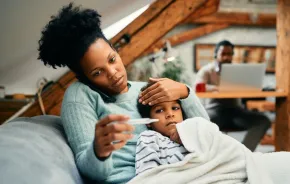 Local mom Lori Pender is “really alarmed.” She recently looked at vaccine “exemption” rate for her child’s school and about 1 in 4 of the kids have not gotten their “shots.” For Pender, that number is “huge and scary,” especially after the record-breaking measles outbreaks which spread across the country and made national news earlier this year.
Local mom Lori Pender is “really alarmed.” She recently looked at vaccine “exemption” rate for her child’s school and about 1 in 4 of the kids have not gotten their “shots.” For Pender, that number is “huge and scary,” especially after the record-breaking measles outbreaks which spread across the country and made national news earlier this year. “We are very worried about the measles,” says Paul Throne of the Washington State Department of Health (DOH). Last year, the U.S. had 644 cases, more than in any other year since 2000, when the Centers for Disease Control and Prevention (CDC) declared the disease “eliminated” from our shores.
Our state also broke a record, according to DOH, with more confirmed cases in the first seven months last year than in the previous five years combined. 2015 is already on track to be worse, with 154 confirmed cases in the first six weeks alone, 118 of those linked to the early Disneyland outbreak, which landed in Washington state in January and sent health officials scrambling to figure out who was exposed. At the same time, a record-breaking unrelated outbreak hit in Clallam County. Confirmed cases were at 174 at the end of May.
Measles is a special concern for public health. "The water droplets from an infected person can hang in the air for two hours after they have left the room,” Throne says. You can get measles from walking into that room later and just breathing.
According to the CDC, measles is also is so infectious that when you get it, 90 percent of the non-immune people around you will, too. Because you can be infectious for days, public health workers have to do detailed investigation of everywhere an infected person went just to try to figure out the scope of the public health risk.
That work doesn’t come cheap. CDC researchers estimate that costs for dealing with just 107 cases in 2011 set back state and local taxpayers an estimated $5.2 million.
Pertussis or “whooping cough” is another vaccine-preventable disease that is easily spread — and on the rise. In 2012, Washington suffered a state-wide epidemic which sickened more than 2,400. In 2014, California’s epidemic hit a record high at nearly 7,000 cases in the first seven months alone. And 61 percent of those who ended up in the hospital were babies under four months of age.
Recent trends
Seattle mom Lisa McConnell-Geisness is concerned about the “medically fragile” kids at her son’s school. “They can’t get shots,” she points out. “How are they getting protected?”
Throne, too, worries about those kids, as well as the elderly and very young.“Our most vulnerable are at greatest risk,” he says, so “they have to count on us.”
He’s talking about herd immunity, which happens when a critical mass of people are vaccinated or immune, making outbreak far less likely and increasing safety for the unprotected. But lower rates of vaccination in the community threaten that protection and put those “most vulnerable” more at risk.
Also troubling to experts is that over the past few years, more parents seem hesitant about vaccines, reports Todd Faubion, Immunization Program Manager for WithinReach Washington. Fabuion thinks the swirl of myths around vaccines means some parents just don’t know what to think, which may be why our state has recently seen vaccine rates decline.
Blame game
Outbreaks are not caused by one factor alone. The 2012 epidemic of whooping cough in our state and elsewhere was based in part on a newer vaccine which was not as strong or long-lasting as hoped. And vaccine exemption rates for schools may not be a completely accurate calculation of risk because a small number of kids who have a personal belief exemption might have been exposed and gotten some immunity some other way.
But unvaccinated and non-immune kids are still playing a part in both causing outbreaks and making them worse. In 2008, a measles epidemic that sickened more than 800 people in California started with a single unvaccinated boy. In 2011, the worst outbreak of measles in Minnesota in 20 years began with an unvaccinated toddler. In 2014, Throne says, the DOH traced our state’s first three measles outbreaks to three people who had not gotten their shots — two of them kids. And a 2010 pertussis epidemic in California was found to have been made worse because it spread through clusters of unvaccinated kids.
Whose rights?
In the face of these new outbreaks, even states like Washington, Oregon and California, which recently beefed up requirements for seeking a personal belief exemption considered getting rid of it altogether. But at the same time, a few states were looking at adding such an exception. And even though the U.S. Supreme Court held in 1922 that public health trumps individual rights when it comes to vaccines, in 2014, a New York family sued their school district, claiming it had violated their rights by making them keep their unvaccinated kids home during a chicken pox outbreak.
Meanwhile, a dad in California sparked public debate by asking school officials to bar kids with personal exemptions during a recent measles outbreak, in order to protect his son, a leukemia survivor. In making his plea, the dad pointedly asked why, if no kid is allowed to bring peanut butter to school because of the risk to one or two kids, parents were being allowed to send unvaccinated, non-immune kids to school during a measles outbreak and cause risk to them all.
Good news
There is some good news in all this debate. “Vaccination is still the community norm,” says Throne. He expects rates to start rising, because getting a personal belief exemption in this state is no longer easier than filling out the vaccine forms in the first place.
And education works. A New York study found that rates of vaccination increased greatly when parents had their questions answered and got help with access and cost.
In our state, the Immunity Community, a pilot program running in Bellingham and the Northshore School District, uses parents to spread the word about the risks and benefits of vaccines. The program was such a success in 2014 that that it is being expanding next year to Spokane and Thurston counties. Says Faubion, “vaccines are better researched than anything else we put in or on our bodies,” and while side-effects do occur, overall vaccines “have been proven safe time and again.” Faubion is confident in education because many worries parents raise have been so soundly disproven, like the claim of a link with autism.
What you need to know
Washington schools and day cares are required to exclude kids who haven’t filed a certificate of immunization or exemption, and Spokane Public School District recently made headlines for doing just that. But there is no requirement to exclude unvaccinated or non-immune kids during a serious outbreak of a vaccine-preventable disease. According to Throne, it is up to each school district and local health department to decide when — and whether — to exclude any kids. If you have concerns, start by contacting your school district to see what, if anything, they have planned.
It might surprise you that there is no requirement that adults at your child’s school get vaccinated or even tell the school their status. While a few school districts like Lake Washington and Shoreline have staff vaccine policies, even those simply “encourage” or “strongly urge” teachers and staff to provide information. If you volunteer at school, you might also be part of the problem. “Many adults don’t know their own vaccine status,” Throne notes. Even parents who think they are covered should check with their docs, because some vaccines given in the 1960s were not effective and you may not be protected.











